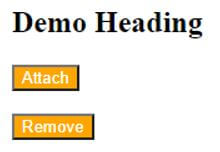Updated April 17, 2023

Introduction to DataSet jQuery
DataSet jQuery is used for data storage. DataSet is of two types one is PS that means Physical Sequential and the other one is PDS that means Partitioned DataSet. The Physical Sequential DataSet is similar to a flat file in windows. It is used to store and retrieve data in sequential order. At the same time, PDS is a group of datasets. It is similar to a folder in windows, which has multiple files in it. jQuery is the most popular JavaScript framework. jQuery is developed to change the way that you write code in JavaScript. It is a super-fast and short JavaScript library that also rectify HTML document whether it is traversing, event handling, animating, and Ajax interactions for rapid web development.
What is DataSet jQuery?
- As humans, we are constantly making observations about the world around us. Even infants can observe something, their favourite toys for instance, and infer a set of characteristics size, colour, shape, etc. By comparing these characteristics, we can make inferences about differences and patterns. Science requires us to take these intuitive processes of observation to a deeper level of careful record-keeping and precision. One way to do this is by constructing a dataset.
- DataSets come in many forms. Here are the basics of one very commonly used form the rectangular long-form DataSet. You probably recognize this as something akin to a spreadsheet. To start, we have to remember that “data” is the plural form of “datum.” A datum is a single piece of information about something. This means a dataset is a structured arrangement of datums. The “something” those bits of information is about is known as the unit of observation.
- The unit of observation is represented by a row in our dataset. Units of observation take on many, many forms throughout scientific disciplines. For example, let’s imagine a survey dataset. In survey research, the unit of observation is typically a person interviewed by the researcher. This means a row in the dataset represents one person. We know that people are extraordinarily complex. And, we can observe many characteristics about them. Those characteristics can be thought of as variables.
- Variables are something about the unit of observation with the potential to show variation. Examples of variables in a survey are age, gender race and income. Consider a variable like age. We can give that variable a simple variable named “age.” But age can be measured in many ways as years or categories and with several types of survey questions. We have highlighted few things about a simple but common type of dataset.
Example of DataSet jQuery
Given below is the example mentioned:
Here in this code, we will see how to implement data() method in jQuery.
Code:
<!DOCTYPE html>
<html>
<head>
<script src="https://ajax.googleapis.com/ajax/libs/jquery/3.4.1/jquery.min.js"></script>
<script>
$(document).ready(function(){
$(".button1").click(function(){
$("div").data("student", "Jack Sparrow");
alert("Student Name = " +$("div").data("student"));
});
$(".button2").click(function(){
$("div").removeData("student");
alert("Student Name = " +$("div").data("Jack Sparrow"));
});
});
</script>
<style>
.button1 {
background-color: orange;
color: white;
}
.button2 {
background-color: orange;
color: white;
}
</style>
</head>
<body>
<h2>Demo Heading</h2>
<button class="button1">Attach</button><br><br>
<button class="button2">Remove</button>
<div></div>
</body>
</html>Output:
jQuery DataSet Method
- jQuery DataSet method provides us with the ability to associate arbitrary datasets with nodes and JavaScript objects. This makes our code more concise and clean. Also jQuery 1.4.3, we can use the dataset method on a general basis, JavaScript objects which open the way to some quite interesting applications interface. Using the data method now the method call is very convenient as it allows you to include it as a part of the chain. Now when you use a data method you need to pass two parameters a key and a value to be stored. That is what we want to do over here. A key we are passing and a value. The key should be a string and the value of that string can be any data structure type including functional arrays and objects.
- There is an alternative syntax as well in which you pass an object as a single parameter. So if we have to give a thing over here. This means that if you have an element or anchor tab for this we can use the data attribute.
- The DataSet method is used to store some data with the associated elements or to get the data already stored in that particular element. So the data method can be used to set or get some data. While removing data method as the name suggest can be used to remove the stored data. Every Ajax call has a parameter in the request, which is data. We can send data to servers using this parameter. While requesting we can do the dollar selector dot method. Here method can contain anything you from load gate post anything and you have to specify URL of the server in data. We can specify the data which we want to send to the server. In the callback, we have to specify the function which you want to perform after the request is successful. So, to send data to the server we have to specify it in the data parameter.
- jQuery also has serialized method in which we shall send the data of the form by using the serialized method. For doing this, first, create a form and specify the basic text HTML.
Conclusion
Here, in this article, we saw a lot of information about jQuery and jQuery datasets. Like what is the jQuery dataset, dataset jQuery method, dataset jQuery example, etc. We also saw data events of jQuery and also for Ajax. jQuery is nothing but the most popular framework of JavaScript. It simplifies HTML files. If you use JavaScript on regular basis, then you should go for jQuery for its enhancement version. It will give you a better experience.
Recommended Articles
This is a guide to DataSet jQuery. Here we discuss the introduction, example and jQuery DataSet method for better understanding. You may also have a look at the following articles to learn more –


